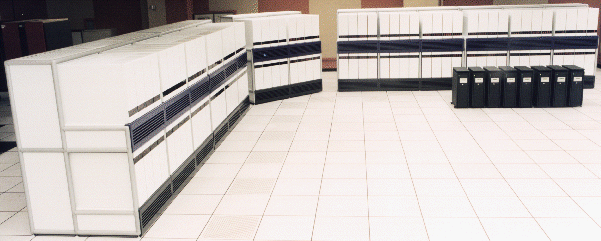I’ll put up another article or 2 if I have time about the Cambridge Raspberry Jam event held on the 14th of July 2012… However…
One of the things that struck me was a comment from Eben that he had a box of 200 Raspberry Pis (for sale) and he noted how easy it was to carry it and made a comment about the potential computing power.
It struck a note with me, as some time back (1988-1995!) I worked for a UK based supercomputer company called Meiko Scientific and one of the projects I worked on was a 256-node supercomputer installed at the Lawrence Livermore National Laboratories in California… (It was one of Meikos CS2 units – Computing Surface mk 2)
This is a picture of that Supercomputer, which at the time was the fastest supercomputer on the planet:

The Meiko CS2 at LLNL
Now, without knowing what you’re looking at, it’s hard to get an idea of how big that is… The cabinets are 2 metres high. The whole is arranged into bays of 3-module widths (4 bays) and 2-module width (the smaller one on a diagonal in the middle). It’s that big “L” shape due to the nature of the cabling between the modules – it goes diagonally under the floor. (The middle sections of each bay is a set of network switches) The stand-alone black boxes are RAID arrays with (from memory) 20 x 4GB drives each.. (they were later moved inside some of the modules, but at that time the mechanicals weren’t in-place)
This was 1993/1994 or thereabouts.
Inside that, amongst other things are 256 compute nodes. 4 to one of the smaller modules that you see. Each smaller module is rated at up to 1 KW in power consumption terms. Those compute modules were about 14 inches square and contained a dual-processor sparc at 66MHz and 128MB of RAM. It ran a variant of Solaris. It booted over the network, but each node also had a local 1GB SCSI drive. (There was an additional control bus and “stuff” associated with that to give us node control like power, monitoring and console which added a little to the board, as well as the high speed data network)
So think about that for a moment… A single Raspberry Pi is probably faster than each of those sparc boards. (and at 700MHz vs 66MHz, it’s a lot faster!) The Pi also has double the RAM. The CS2 boards did have a blisteringly fast (for the time) communications network – 750Mbits/sec with a very low latency between nodes. A lot faster than the Pi’s max. of 100Mbits/sec. into a switched Ethernet network, however I could build an equivalent “supercomputer” based on 256 Raspberry Pis, put it under my desk and power it from a 13A socket. And that’s just using the ARMs – not even thinking of the GPUs…
Still – it’s somewhat interesting to think that Eben can carry a box of 200 Pi’s representing something that 20 years ago was simply incomprehensible to think about at the time.
(Minor update to change network speeds to bits/sec!)

The Pi has 10/100 ethernet… so it’s faster in every respect. Interesting piece.
Bits and Bytes!
The Pi runs at 100Mbits/sec -> 10MBytes/sec
The CS2 was running at 75M Bytes/sec node to node, at a time when 10Mb/sec (ie 1MB/sec) Ethernet was king and we were only just starting to move away from co-ax…
-Gordon
Ah! I stand corrected. Thanks for clarifying.
Bits & Bytes – easy to get confused! I’ve updated the article to clarify it too.
Cheers,
-Gordon
The ARM CPUs are probably somewhat more efficient per-clock than the SPARCs, too. I bet you could set up a 20-node RasPi Beowulf cluster that could embarrass the Computing Surface for most tasks, only taking a hit when something that relied heavily on super-fast internode transfers was involved. Though some of the 7.5x difference could probably be clawed back by sacrificing a bit of (possibly otherwise-wasted) compute time in favour of de/compressing the network data.
Some good points!
ARM and Sparc are both RISC – so more or less one instruction per cycle – the Sparc does have more registers, and a bigger cache, but it never seemed to scale to higher clock speeds which was always the intention IIRC… Ah well!
And add in the GPU and it wouldn’t surprise me if only 5 or 6 Pi’s could beat the old CS2 in terms of pure compute performance…
-Gordon
Hi!! Looks like another you have read your mind … 🙂
11SEPT 2012 Computational Engineers at the University of Southampton have built a supercomputer from 64 Raspberry Pi computers and Lego.
I saw that. Pretty impressive..
-Gordon